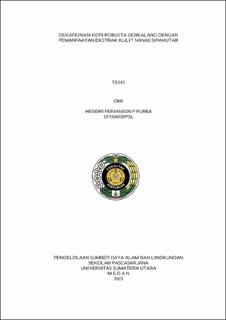Dekafeinasi Kopi Robusta Sidikalang dengan Pemanfaatan Ekstrak Kulit Nanas Sipahutar
Decaffeination of Sidikalang Robusta Coffee By Using Sipahutar Pineapple Peel Extract

Date
2023Author
Purba, Hendri Ferianson P
Advisor(s)
Sinaga, Hotnida
Husin, Amir
Metadata
Show full item recordAbstract
In 2021, the waste pineapple peels of Sipahutar pineapple production was 47,970.6 tons which could be used as Bromelain enzyme. The decrease in the farmers’ interest in developing Robusta coffee caused by its high caffeine taste and bad quality, compared with Arabica coffee. The solution to increase its quality can be done through fermentation, using Sipahutar pineapple peel extract. The objective of the research was to do decaffeination of Sidikalang Robusta coffee through the process of fermentation by the treatment concentration of Sipahutar pineapple peel extract and the fermentation duration. The research was conducted in the Analisa Kimia dan Bahan Pangan (Chemical and Food Stuff Analysis) Laboratory, Food Science and Technology Study Program, Faculty of Agriculture, University of Sumatera Utara, from Januari until June, 2023. The research use Factorial RAL (Complete Random Design): the first factor was 6 levels of pineapple peel extract of 0% (A0), 10% (A1), 20% (A2), 30% (A3), 40% (A4), and 50% (A5). The second factor was fermentation duration with 4 levels; 12 hour (B1), 24 hour (B2), 36 hour (B3), and 48 hour (B4). The result of the research showed that the lowest caffein content was 0.13% of A5B3 treatment interaction and the highest one was 0.45% of A0B2 treatment interaction. The highest TSS (Total Dissolved Solid) of 3.00Brix was obtained from A5B4 treatment interaction and the lowest one (2.00Brix) was obtained from A0B1. The highest pH was 5.26 of A0B3 treatment interaction and the lowest one was 4.9 0f A3B4 treatment interaction. The highest water content was 2.4% of the A3B1 treatment interaction and the lowest one was 1.23% of A0B3 treatment interaction. The highest fat content was 31.22% of A0B2 treatment interaction, and the lowest one was 10.11% of A5B3 treatment interaction. The highest ash content was 4.8% of A0B1 treatment interaction and the lowest one was 3.90% of A5B4 treatment interaction. The highest protein content was 14.13 of A0B1 treatment interaction and the lowest one was 8.94% of A4B4 treatment interaction. The result of organoleptic analysis, using cupping test, showed that, all in all, interaction was included in specialty score except A0B1, A0B3, A5B2, and A5B2 with its cupping test final score was < 80.00
